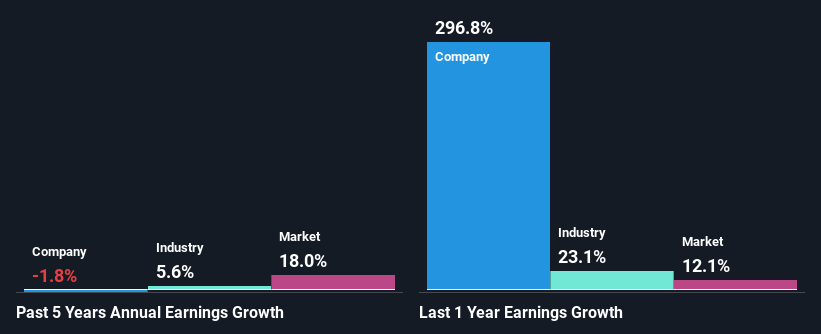Are SalMar ASA's (OB:SALM) Mixed Financials The Reason For Its Gloomy Performance on The Stock Market?

With its stock down 13% over the past three months, it is easy to disregard SalMar (OB:SALM). It is possible that the markets have ignored the company's differing financials and decided to lean-in to the negative sentiment. Fundamentals usually dictate market outcomes so it makes sense to study the company's financials. Particularly, we will be paying attention to SalMar's ROE today.
ROE or return on equity is a useful tool to assess how effectively a company can generate returns on the investment it received from its shareholders. Simply put, it is used to assess the profitability of a company in relation to its equity capital.
See our latest analysis for SalMar
How Do You Calculate Return On Equity?
ROE can be calculated by using the formula:
Return on Equity = Net Profit (from continuing operations) ÷ Shareholders' Equity
So, based on the above formula, the ROE for SalMar is:
19% = kr3.7b ÷ kr20b (Based on the trailing twelve months to June 2024).
The 'return' refers to a company's earnings over the last year. That means that for every NOK1 worth of shareholders' equity, the company generated NOK0.19 in profit.
Why Is ROE Important For Earnings Growth?
So far, we've learned that ROE is a measure of a company's profitability. Depending on how much of these profits the company reinvests or "retains", and how effectively it does so, we are then able to assess a company’s earnings growth potential. Assuming all else is equal, companies that have both a higher return on equity and higher profit retention are usually the ones that have a higher growth rate when compared to companies that don't have the same features.
SalMar's Earnings Growth And 19% ROE
To start with, SalMar's ROE looks acceptable. Further, the company's ROE compares quite favorably to the industry average of 8.7%. Given the circumstances, we can't help but wonder why SalMar saw little to no growth in the past five years. We reckon that there could be some other factors at play here that's limiting the company's growth. Such as, the company pays out a huge portion of its earnings as dividends, or is faced with competitive pressures.
Next, on comparing with the industry net income growth, we found that the industry grew its earnings by 5.6% over the last few years.

Earnings growth is an important metric to consider when valuing a stock. The investor should try to establish if the expected growth or decline in earnings, whichever the case may be, is priced in. By doing so, they will have an idea if the stock is headed into clear blue waters or if swampy waters await. Is SalMar fairly valued compared to other companies? These 3 valuation measures might help you decide.
Is SalMar Using Its Retained Earnings Effectively?
SalMar's very high three-year median payout ratio of 103% suggests that the company is paying its shareholders more than what it is earning. The absence in growth is therefore not surprising. Its usually very hard to sustain dividend payments that are higher than reported profits. That's a huge risk in our books. Our risks dashboard should have the 2 risks we have identified for SalMar.
In addition, SalMar has been paying dividends over a period of at least ten years suggesting that keeping up dividend payments is way more important to the management even if it comes at the cost of business growth. Existing analyst estimates suggest that the company's future payout ratio is expected to drop to 76% over the next three years. Accordingly, the expected drop in the payout ratio explains the expected increase in the company's ROE to 28%, over the same period.
Summary
In total, we're a bit ambivalent about SalMar's performance. While the company does have a high rate of return, its low earnings retention is probably what's hampering its earnings growth. That being so, the latest industry analyst forecasts show that the analysts are expecting to see a huge improvement in the company's earnings growth rate. To know more about the latest analysts predictions for the company, check out this visualization of analyst forecasts for the company.
New: Manage All Your Stock Portfolios in One Place
We've created the ultimate portfolio companion for stock investors, and it's free.
• Connect an unlimited number of Portfolios and see your total in one currency
• Be alerted to new Warning Signs or Risks via email or mobile
• Track the Fair Value of your stocks
Have feedback on this article? Concerned about the content? Get in touch with us directly. Alternatively, email editorial-team (at) simplywallst.com.
This article by Simply Wall St is general in nature. We provide commentary based on historical data and analyst forecasts only using an unbiased methodology and our articles are not intended to be financial advice. It does not constitute a recommendation to buy or sell any stock, and does not take account of your objectives, or your financial situation. We aim to bring you long-term focused analysis driven by fundamental data. Note that our analysis may not factor in the latest price-sensitive company announcements or qualitative material. Simply Wall St has no position in any stocks mentioned.
About OB:SALM
SalMar
An aquaculture company, produces and sells farmed salmon in Asia, North America, Europe, and internationally.
High growth potential with solid track record.
Similar Companies
Market Insights
Community Narratives



